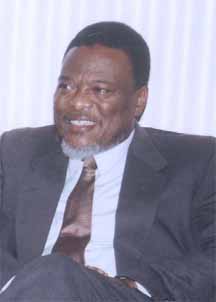Prime Minister Samuel Hinds is advocating the setting up of a mining bank in Guyana at a juncture when, he says, high gold prices and attendant high profit margins allow miners to place some of their earnings in shares in such an institution.
In a message published in the recently released inaugural issue of the Guyana Gold and Diamond Miners Association’s (GGDMA) magazine, The Shout, the Prime Minister said the small and medium scale gold and diamond mining sector had arrived at a juncture where further evolution, growth and development is demanded of it.

The Prime Minister disclosed that the 308,438 ounces of gold declared last year now meant that small and medium scale gold miners are now producing at the level that was achieved by Omai Gold Mines Ltd, the single largest investment ever in the country’s mining sector. The difference between the OmaiI years and the contemporary gold mining sector, the Prime Minister said, was that “where there was one Omai employing 1,000 persons at one location we now have more than 800 individual operations engaging 10,000 persons across two thirds of our country and recovering annually some 15 ounces to 1,500 ounces each, with more than 2,000 persons selling gold to the Gold Board and its licensed traders.”
In an invited comment, Executive Secretary of the GGDMA Edward Shields told Stabroek Business that initiatives such as the Prime Minister’s mining bank proposal may well find favour with the sector since the current focus was on the growth and development of gold mining in Guyana. Shields reminded that local miners once enjoyed access to borrowing from the former Guyana Agricultural Development Bank (Gaibank), where a mining desk had been established. He said that miners desirous of securing loans for investment from Gaibank were required to raise 40% of the required capital after which the bank would provide the remaining 60%.
Shields told Stabroek Business that he believed the mining sector had become an area of attention for commercial banks given the prevailing high gold yield and high world market prices. Citizens Bank, whose General Manager Eton Chester is a member of the Board of Directors of the Guyana Geology and Mines Commission (GGMC) has plans to set up a branch at Charity, a move which Shields says will be strategically significant to the mining sector.
The prospects of increased focus on securing financing for the mining sector is also raised in a message published in the magazine by the Guyana Geology and Mines Commission (GGMC) in which it says that it is “working diligently to open up, strengthen and widen the availability of financial instruments for small and medium scale gold and diamond miners, such as recognizing and leveraging equity from prospecting and mining properties; obtaining loans; project financing; hire purchase and grub-staking.”
Despite his upbeat assessment of the state of the mining sector, however, the Prime Minister’s message contains an unmistakable hint that challenging times may lie ahead for the industry and more particularly for small and medium-scale miners. Alluding to the imminent new regulations in the sector to take account of its pursuit of more stringent environmental practices, the Prime Minister said that small and medium scale mining operations must rise to the level of large scale mining by “minimizing and mitigating negative environmental and social impacts.”
The message raises, not for the first time, the imminent introduction of new regulations which, among other things, will require miners to provide the authorities with six months notice prior to commencing mining operations and grants the Guyana Forestry Commission (GFC) a considerable measure of veto over mining activity. Miners in the small and medium scale sector have set their face against some of the new regulations including, particularly, the six-month notice prior to the commencement of mining activity and the role which the GFC is set to play in the mining industry. The GGDMA has openly expressed its unease over some of the new regulations and have even dropped a broad hint that government might find it difficult to secure compliance with the new regulations in a physical environment where official policing is limited.
In his message, however, the Prime Minister made it clear that government intends to push ahead with the new regulations, warning the miners that they must anticipate “notice of clearing in preparation for mining” which will “inevitably become a requirement and that prompt restoration must follow mining.”
In its new publication the GGDMA has published sections of a letter sent to President Bharrat Jagdeo calling for the setting aside of “an accumulative area” of 1.6 million acres of the entire forest area of approximately 40 million acres which it says “would enable the sector to continue mining as it has been doing for over a century. The letter, to the President, the GGDMA says, “went on to commit miners to pursuing the necessary changes that will allow for the improvement of environmental mining standards which can only lead to a win-win situation for all stakeholders concerned.”
Whether government will allow the sector to “operate as it has been doing for over a century” is doubtful. Public statements by government suggest that there is a considerable absence of trust between the two sides. The lack of effective state policing of the sector coupled with persistent charges of corruption among state-employed mining inspectors has been responsible, in large measure for initiatives designed to impose stricter mining regulations. A few years ago, the Prime Minister referred to what he described as a “mining frenzy” in the industry, which, he said, was linked to the high world market price for gold.
Despite the strained relations between parts of the mining sector and government, however, the GGDMA is upbeat about the immediate-term prospects for the industry, noting that “the trend of increased production and higher declarations has prompted the Guyana Gold Board to increase the 2011 target to 320,000 ounces.”








